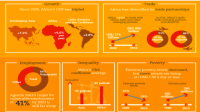Africa needs development strategies more coherent and prioritizing improved public action to stand up to the challenges of growth, jobs and inequalities prompted by the continent’s remarkable emergence, new report says.
Africa’s Development Dynamics 2018, the first annual economic report by the African Union Commission since its creation in 1963, was released today at the Commission’s headquarters in Addis Ababa, Ethiopia.
The report finds that a favourable trend in commodities prices, strong domestic demand, progress in the pursuit of macroeconomic policies and strategies to diversify national economies have been major drivers of the continent’s recent growth, which is forecast to reach 4% annually between 2018 and 2020.
The decision by certain countries to increase investment in infrastructure and the growing number of commercial partnerships – with China, India and other emerging countries – have also proved judicious.
The report is the first issue of a new joint report by the African Union Commission (AUC) produced in collaboration with the OECD Development Centre.
Since the beginning of the century, Africa has ranked second behind Asia on the leaderboard of the world’s fastest-growing regions, with average annual growth in gross domestic product (GDP) of 4.7% between 2000 and 2017. This level of growth has, however, been insufficient to trigger fundamental changes.
The report focuses on “growth, jobs and inequalities” and highlights the importance of accelerating the structural transformation of African economies. Growth is still inconsistent; between 2016 and 2020, just three of the continent’s 55 countries should reach the targeted average annual growth of over 7% set by the African Union’s Agenda 2063.
This growth has not created enough decent jobs, moreover, and 282 million people are currently working in unstable employment. At the current rate, 66% of jobs will still be insecure in 2022, a figure far higher than the targeted 41% for 2023. And the population of Africa is rising rapidly – a quarter of the global population will be African by 2050.
The report also draws attention to the need to increase productivity: African businesses are lagging far behind the rest of the world in sectors with high job-creation potential, such as agribusiness, construction, leather, light manufacturing and logistical services.
Furthermore, growth in Africa has less of an impact than elsewhere in the world on reducing inequalities and improving well-being. If the continent’s Gini coefficient had fallen by seven further points to 35 – the same level as in Asia – growth would have lifted another 130 million people out of poverty between 1990 and 2016. Despite a reduction, extreme poverty still concerns 35% of the African population, or 395 million people.
The report also reveals the mixed performances of different African regions in terms of growth, jobs and inequalities.
- East Africa has enjoyed stronger and more resilient economic growth than the other regions, at over 4% per year since 1990, on the back of a more diversified economy.
- In addition to the underemployment and vulnerable employment that characterise most of the African labour markets, some countries in North and Southern Africa face high structural employment.
- In Central Africa, the number of jobs in the formal economy has been falling since 2015.
- East Africa and West Africa managed to reduce extreme poverty by 23 and 12 percentage points respectively between 1990 and 2013.
- Inequality in Africa is most prevalent in Southern Africa, which, in terms of income, contains six out of the ten most unequal countries in the world.
The report stresses that public action is the key to improved performances when it comes to growth, jobs and inequalities. Domestic strategies are more effective when they encourage good inter-sectoral co-ordination of government action, the active participation of economic stakeholders and citizens, and a regional approach to development.
“Africa has significant assets for addressing its issues: a young and enterprising population, regions undergoing fundamental change with growth in the countryside and rapid urbanisation, considerable natural resources, dynamic economies, rich ecosystems, and a solid diaspora. However, far too often, public policies have failed to leverage these assets effectively. The implementation of the reform programme as set out in Agenda 2063 requires an increase in government capacities, greater responsibility, transparency, co-ordination and the promotion of positive institutional action”, stated Victor Harison, Commissioner of Economic Affairs of the AUC, while launching the report.

“Africa also has a vital role to play in the extensive reshaping of the framework of international co-operation as required by the Sustainable Development Goals. The continent is an extraordinary cradle of innovation for development strategies, and it is important that its partners pay it greater attention and better support the implementation of its creative strategies”, added Mario Pezzini, Director of the OECD Development Centre and Special Advisor to the OECD Secretary-General on Development, who was also present in Addis Ababa.
Africa’s Development Dynamics 2018 proposes ten decisive strategic actions in three areas – economic, social and institutional – for reaching the development targets in Agenda 2063.


